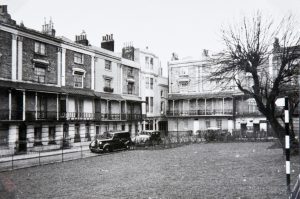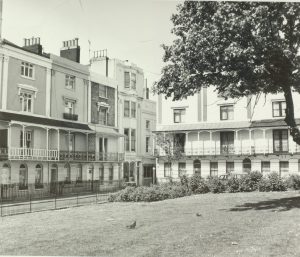At the outbreak of World War 2, the War Office requisitioned the gardens in many of Brighton’s squares for civil defence purposes. Our three gardens were no exception. The railings were removed and the gardens dug up to build air raid shelters. Clarence, Russell and Regency squares each had two air raid shelters in their central gardens. Each shelter had a brick entrance and a flight of steps leading down to a space intended to accommodate 100 people, sitting upright on long benches.
Regency Square’s garden also had a reservoir of water at the seafront end for fire fighting.
In 1948, Brighton Corporation received compensation from the government to restore the gardens. A total of £1,175 was allocated to reinstating the Russell Square garden, £1,230 to Regency Square. The money was spent on clearing the sites, laying paths, sowing grass, planting shrubs.
Other squares, including Norfolk, Powis and New Steine had also been dug up for air raid shelters. Brighton’s Parks Superintendent hoped to use the post-war restoration to impose a uniform style on all the garden squares in the town. But he wrote that Regency Square “Demands a regularity and order which it has never had and I am anxious that this important site is treated and kept in the essentially English art of landscape design”.
Restoration of Regency Square was completed in 1949, but fell short of the Superintendent’s ambitions. It was once again a large lawn with border shrubs.
Shortages of materials delayed the restoration of other squares. In 1951, the Parks Superintendent reported that it would be another two years before railings could be replaced in Russell Square. When the railings finally arrived, they were of modern design.

Russell Square, post-WW2. James Gray Collection. Courtesy of The Regency Society.

Russell Square 1970s. Royal Pavilion & Museums, Brighton & Hove.
